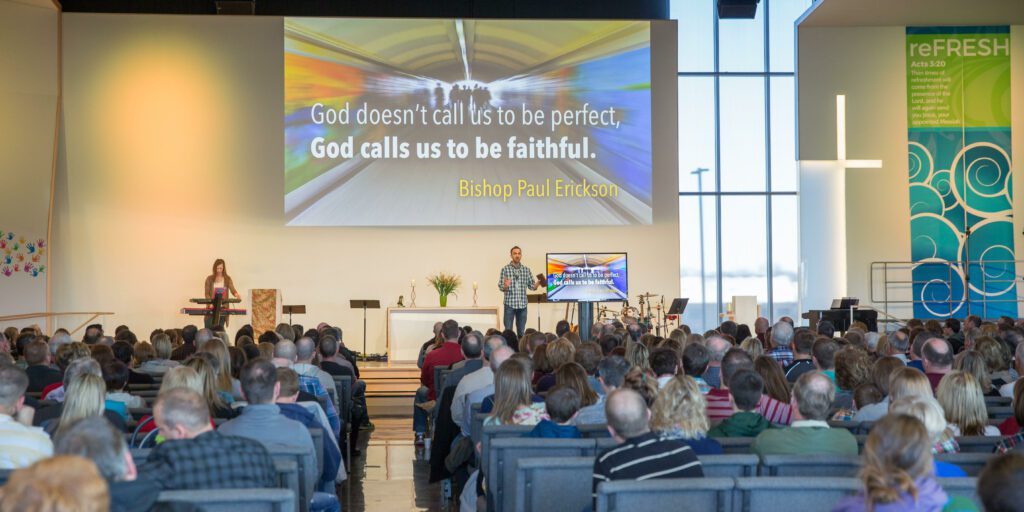Does anybody else want a crystal ball to help them figure out how to lead in the midst of this disruptive and chaotic world we live in?
Well, I don’t have a crystal ball, but I have learned some lessons from my time leading change in a congregation over the past 24 months. Most of this was wisdom gained from hindsight, so learn from my mistakes and missteps and enjoy a (slightly) less chaotic journey into the future!
What first interested you in ministry?
For me, it was running the PowerPoint slides as a fourth grader for Spirit of Joy Lutheran Church, an ELCA redevelopment on the east side of Orlando, Florida. From that opportunity I caught a vision for a creative new way of proclaiming the story of Jesus—using visual media.
I got a degree in media production from Florida State University and worked in worship design and production for Ginghamsburg Church (Tipp City, OH), Church of the Resurrection (Leawood, KS), and Augsburg Fortress Publishers (Minneapolis, MN). In 2010, after multiple trips to Burundi, Africa, I felt called to become pastor—combining my passion for media and serving others.
In six years as an ordained pastor in the ELCA, I have served as the discipleship pastor at Lutheran Church of Hope’s campus in Ankeny, Iowa, and most recently as the pastor of The Common Table, a redevelopment of a 90 year old struggling Lutheran faith community in Decatur, Georgia. Common Table is passionate about gathering people in grace-filled communities to fight for justice and healing so everyone can find hope for a better tomorrow.

Remember that change means loss
Leading change is not a smooth journey. When I arrived at my new congregation in the summer of 2019, they said they wanted to pursue resurrection instead of closing their doors and that they were willing to put everything on the table to do so. What I didn’t realize at the time was that, for so many of these folks, the idea of change was much more palatable than the actual experience of change.
When I think of change and the church, it brings back memories of growing up in a congregation that worshipped under tents and in schools and ended up permanently located in a renovated bowling alley. Change, for me, is synonymous with life and excitement and potential.
But I know most church folks aren’t as eager to engage with change and that is primarily due to their aversion to loss. As we began changing things in our worship, community life, and our facility, it meant people were losing the traditions and practices that had shaped many years of memories and experiences.
Trust your gut
There were multiple points in our change journey where I leaned too heavily on the opinions of others. Listening to others—in the congregation and community—is important, but don’t listen to others so much that you stop listening to yourself. Trust that God has called you to this place and that God is at work in your life, too. I’d also encourage you to trust your gut when it comes to self care and needing a break. The work of leading change is grueling and pacing yourself will be key to the overall success of the journey.
Slow and steady really does win the race
One of the major places I leaned too heavily on the opinions of others was when it came to the timeline for our change journey. When I first arrived, the congregation’s leaders hoped to relaunch in four months. There was a fear that taking more time would lead to lost momentum and further financial strain. However, I quickly came to realize that more time was needed to:
- walk people through their grief;
- re-anchor our common life to Jesus instead of our worship practices; and
- work on the systems and structures that would help us engage new people and grow in a healthy way.
We could go faster, but that would mean sacrificing the depth of our transformation (with the potential for relapse to the old ways of doing things) and/or burning people out in the process.
I really think the expectation for most congregations needs to be that change and transformation will take years, not months, and often needs to start with a focus on transforming the hearts and discipleship practices of the existing congregation.
Lead by example
For years I’ve been guided by a mantra I learned from Jo Saxton, “people can’t be what they can’t see.” I knew this to be true of my discipleship relationships: we need real life examples if we are going to learn how to embody a Jesus way of life ourselves. But I came to realize this is also important when leading change. Don’t just rely on your past success and experience; model it for your current leaders. Walk with them through the valley of loss, change, and transformation. It seems obvious now, but in the chaos and stress of the change journey, I forgot this simple principle.
Reflect
What is your relationship with change? How about your congregation?
How are you prioritizing time for self-reflection, dreaming, and discernment?
What does a steady and sustainable pace of change look like for your congregation? Map it out step by step.
In what ways can you help people celebrate, remember, grieve, and process their loss, as you pursue change?
How can you model the change you are pursuing for your leaders and congregation? What stories can you tell in your sermons or emails or on social media?




